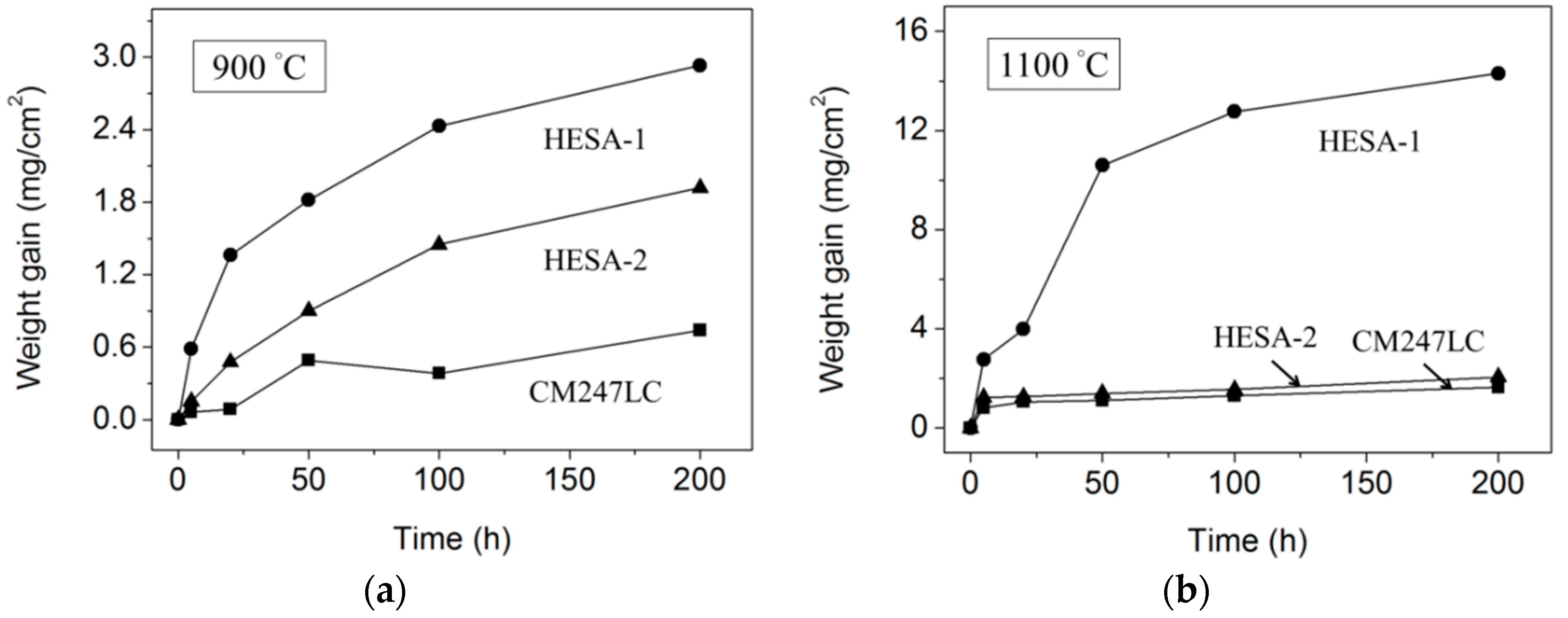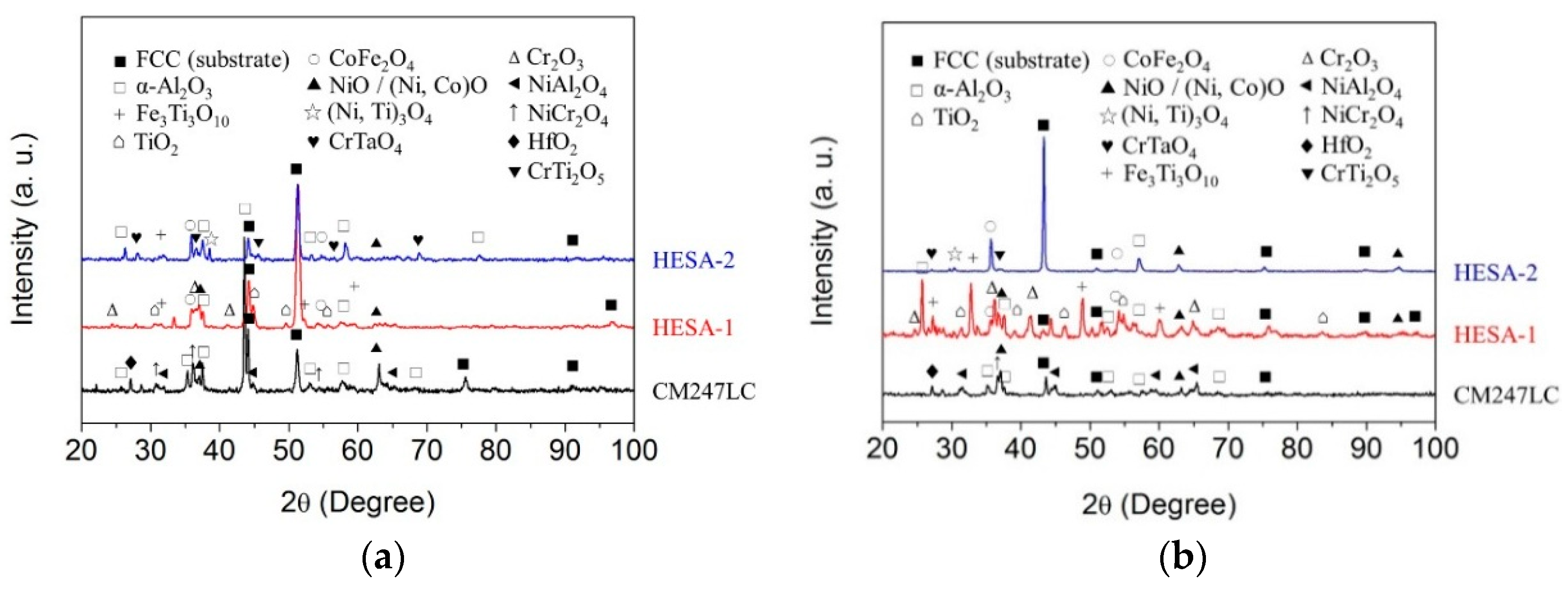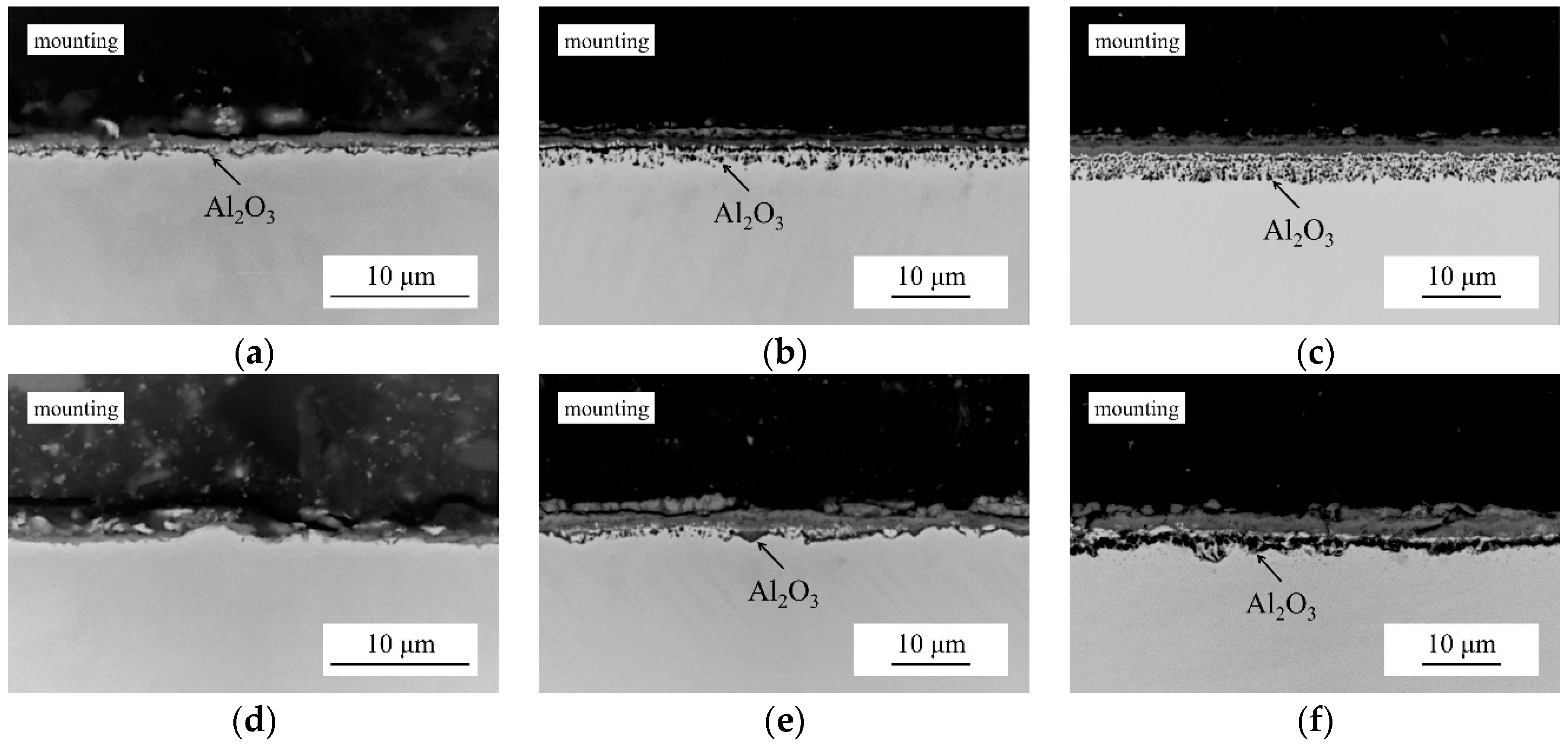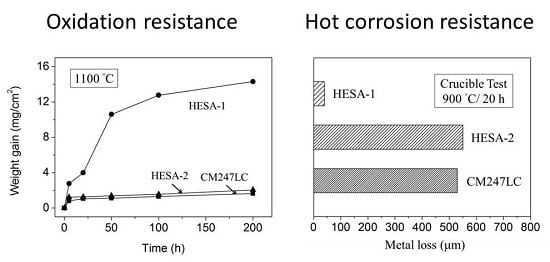High Temperature Oxidation and Corrosion Properties of High Entropy Superalloys
Abstract
:1. Introduction
2. Material and Methods
3. Results
3.1. Oxidation Behaviour
3.2. Hot Corrosion Behaviour
4. Discussion
5. Conclusions
Acknowledgments
Author Contributions
Conflicts of Interest
References
- Furrer, D.; Fecht, H. Ni-based superalloys for turbine discs. JOM 1999, 51, 14–17. [Google Scholar] [CrossRef]
- Caron, P.; Khan, T. Evolution of Ni-based superalloys for single crystal gas turbine blade applications. Aerosp. Sci. Technol. 1999, 3, 513–523. [Google Scholar] [CrossRef]
- Yeh, A.C.; Tin, S. Effects of Ru and Re additions on the high temperature flow stresses of Ni-base single crystal superalloys. Scripta. Mater. 2005, 52, 519–524. [Google Scholar] [CrossRef]
- Pollock, T.M.; Tin, S. Nickel-based superalloys for advanced turbine engines: Chemistry, Microstructure, and Properties. J. Propul. Power 2006, 22, 361–374. [Google Scholar] [CrossRef]
- Reed, R.C. The Superalloys: Fundamentals and Applications; Cambridge University Press: Cambridge, UK, 2006. [Google Scholar]
- MacKay, R.A.; Gabb, T.P.; Smialek, J.L.; Nathal, M.V. A New Approach of Designing Superalloys for Low Density. JOM 2010, 62, 48–54. [Google Scholar] [CrossRef]
- Koizumi, Y.; Kobayashi, T.; Yokokawa, T.; Zhang, J.X.; Osawa, M.; Harada, H.; Aoki, Y.; Arai, M. Development of next-generation Ni-base single crystal superalloys. Superalloys 2004. [Google Scholar] [CrossRef]
- Kawagishi, K.; Harada, H.; Sato, A.; Sato, A.; Kobayashi, T. The oxidation properties of fourth generation single-crystal nickel-based superalloys. JOM 2006, 58, 43–46. [Google Scholar] [CrossRef]
- Reed, R.C.; Tao, T.; Warnken, N. Alloys-By-Design: Application to Nickel-Based Single Crystal Superalloys. Acta Mater. 2009, 57, 5898–5913. [Google Scholar] [CrossRef]
- Sato, A.; Chiu, Y.L.; Reed, R.C. Oxidation of nickel-based single-crystal superalloys for industrial gas turbine applications. Acta Mater. 2011, 59, 225–240. [Google Scholar] [CrossRef]
- Evans, A.G.; He, M.Y.; Suzuki, A.; Gigliotti, M.; Hazel, B.; Pollock, T.M. A mechanism governing oxidation-assisted low-cycle fatigue of superalloys. Acta Mater. 2009, 57, 2969–2983. [Google Scholar] [CrossRef]
- Deb, D.; Iyer, S.R.; Radhakrishnan, V.M. A comparative study of oxidation and hot corrosion of a cast nickel base superalloy in different corrosive environments. Mater. Lett. 1996, 29, 19–23. [Google Scholar] [CrossRef]
- Tong, J.; Dalby, S.; Byrne, J.; Henderson, M.; Hardy, M. Creep, fatigue and oxidation in crack growth in advanced nickel base superalloys. Int. J. Fatigue 2001, 23, 897–902. [Google Scholar] [CrossRef]
- Eliaz, N.; Shemesh, G.; Latanision, R.M. Hot corrosion in gas turbine components. Eng. Fail. Anal. 2002, 9, 31–43. [Google Scholar] [CrossRef]
- Yeh, J.W.; Chen, S.K.; Lin, S.J.; Gan, J.Y.; Chin, T.S.; Shun, T.T.; Tsau, C.H.; Chang, S.Y. Nanostructured high-entropy alloys with multiple principal elements: Novel Alloy Design Concepts and Outcomes. Adv. Eng. Mater. 2004, 6, 299–303. [Google Scholar] [CrossRef]
- Hsu, C.Y.; Juan, C.C.; Wang, W.R.; Sheu, T.S.; Yeh, J.W.; Chen, S.K. On the superior hot hardness and softening resistance of AlCoCrxFeMo0.5Ni high-entropy alloys. Mater. Sci. Eng. A 2011, 528, 3581–3588. [Google Scholar] [CrossRef]
- Tsai, K.Y.; Tsai, M.H.; Yeh, J.W. Sluggish diffusion in Co-Cr-Fe-Mn-Ni high-entropy alloys. Acta Mater. 2013, 61, 4887–4897. [Google Scholar] [CrossRef]
- Tsai, M.H.; Yeh, J.W. High-entropy alloys: A Critical Review. Mater. Res. Lett. 2014, 2, 107–123. [Google Scholar] [CrossRef]
- Yeh, A.C.; Tsao, T.K.; Chang, Y.J.; Chang, K.C.; Yeh, J.W.; Chiou, M.S.; Jian, S.R.; Kuo, C.M.; Wang, W.R.; Murakami, H. Developing new type of high temperature alloys—High Entropy Superalloys. Int. J. Metall. Mater. Eng. 2015. [Google Scholar] [CrossRef]
- Yeh, A.C.; Chang, Y.J.; Tsai, C.W.; Wang, Y.C.; Yeh, J.W.; Kuo, C.M. On the Solidification and Phase Stability of a Co-Cr-Fe-Ni-Ti High-Entropy Alloy. Metall. Mater. Trans. A 2014, 45A, 184–190. [Google Scholar] [CrossRef]
- Harris, K.; Erickson, G.L.; Schwer, R.E. MAR M 247 Derivations—CM 247 LC DS Alloy and CMSX Single Crystal Alloys: Properties & Performance. Superalloy 1984. [Google Scholar] [CrossRef]
- Yeh, A.C.; Yang, K.C.; Yeh, J.W.; Kuo, C.M. Developing an advanced Si-bearing DS Ni-base superalloy. J. Alloy. Compd. 2014, 585, 614–621. [Google Scholar] [CrossRef]
- Cryosystems, O. Crystallographica Search-Match. J. Appl. Crystallogr. 1999, 32, 379–380. [Google Scholar] [CrossRef]
- Das, D.; Singh, V.; Joshi, S. High temperature oxidation behaviour of directionally solidified nickel base superalloy CM–247LC. Mater. Sci. Technol. 2003, 19, 695–708. [Google Scholar] [CrossRef]
- Chiou, M.S.; Jian, S.R.; Yeh, A.C.; Kuo, C.M. Effects of Aluminum Addition on the High Temperature Oxidation Behavior of CM-247LC Ni-based Superalloy. Int. J. Electrochem. Sci. 2015, 10, 5981–5993. [Google Scholar]
- Seal, S.; Kuiry, S.; Bracho, L.A. Studies on the surface chemistry of oxide films formed on IN-738LC superalloy at elevated temperatures in dry air. Oxid. Met. 2001, 56, 583–603. [Google Scholar] [CrossRef]
- Donachie, M.J.; Donachie, S.J. Superalloys: A Technical Guide; ASM International: Novelty, OH, USA, 2002. [Google Scholar]
- Li, M.; Sun, X.; Jin, T.; Guan, H.; Hu, Z. Oxidation Behavior of a Single-Crystal Ni-Base Superalloy in Air—II: At 1000, 1100, and 1150 C. Oxid. Met. 2003, 60, 195–210. [Google Scholar] [CrossRef]
- Kumar, S.; Mudgal, D.; Singh, S.; Prakash, S. Cyclic oxidation behavior of bare and Cr3C2–25 (NiCr) coated super alloy at elevated temperature. Adv. Mater. Lett. 2013, 4, 754–761. [Google Scholar]
- Liu, L.; Wu, S.; Dong, Y.; Lü, S. Effects of alloyed Mn on oxidation behaviour of a Co-Ni-Cr-Fe alloy between 1050 and 1250 °C. Corros. Sci. 2015, 104, 236–247. [Google Scholar] [CrossRef]
- Bose, S. High-Temperature Corrosion. In High Temperature Coatings; Bose, S., Ed.; Butterworth-Heinemann: Burlington, VT, USA, 2007; pp. 53–70. [Google Scholar]
- Bornstein, N.S.; DeCrescente, M.A. The Role of Sodium and Sulfur in the Accelerated Oxidation Phenomena–Sulfidation. Corrosion 1970, 26, 309–314. [Google Scholar] [CrossRef]
- Pettit, F.; Meier, G.; Gell, M.; Kartovich, C.; Bricknel, R.; Kent, W.; Radovich, J. Oxidation and hot corrosion of superalloys. Metal. Soc. AIME Warrendale PA 1984, 651, 651–687. [Google Scholar]
- Giggins, C.S.; Pettit, F.S. Oxidation of Ni-Cr-Al Alloys between 1000 Degrees and 1200 Degrees C. J. Electrochem. Soc. 1971, 118, 1782–1790. [Google Scholar] [CrossRef]
- Chen, S.L.; Daniel, S.; Zhang, F.; Chang, Y.A.; Yan, X.Y.; Xie, F.Y.; Schmid-Fetzer, R.; Oates, W.A. The PANDAT software package and its applications. Calphad 2002, 26, 175–188. [Google Scholar] [CrossRef]
- Stott, F.H.; Wood, G.C.; Stringer, J. The Influence of Alloying Elements on the Development and Maintenance of Protective Scales. Oxid. Met. 1995, 44, 113–145. [Google Scholar] [CrossRef]
- Birks, N.; Meier, G.H.; Pettit, F.S. Forming Continuous Alumina Scales to Protect Superalloys. JOM 1994, 46, 42–46. [Google Scholar] [CrossRef]
- Gordon, A.P.; Trexler, M.D.; Neu, R.W.; Sanders, T.J.; McDowell, D.L. Corrosion kinetics of a directionally solidified Ni-base superalloy. Acta Mater. 2007, 55, 3375–3385. [Google Scholar] [CrossRef]
- Suzuki, A.S.; Kawagishi, K.; Yokokawa, T.; Harada, H.; Kobayashi, T. A New Oxide Morphology Map: Initial Oxidation Behavior of Ni-Base Single-Crystal Superalloys. Metall. Mater. Trans. A 2012, 43, 155–162. [Google Scholar] [CrossRef]
- Mrowec, S.; Werber, T.; Zastawni, M. Mechanism of High Temperature Sulphur Corrosion of Nickel-Chromium Alloys. Corros. Sci. 1966, 6, 47–68. [Google Scholar] [CrossRef]
- Rapp, R.A.; Goto, K. The Hot Corrosion of Metals by Molten Salts. In Proceedings of the Second International Symposium on Molten Salts; Physical Electrochemistry Division, Electrochemical Society: Pennington, NJ, USA, 1981; p. 159. [Google Scholar]
- Rapp, R.A. Chemistry and electrochemistry of hot corrosion of metals. Mater. Sci. Eng. 1987, 87, 319–327. [Google Scholar] [CrossRef]
- Beltran, A.M.; Shores, D.A. Hot Corrosion. In The Superalloys; Wiley-Interscience: New York, NY, USA, 1972; pp. 317–339. [Google Scholar]
- Qiao, M.; Zhou, C.G. Hot corrosion behavior of Co modified NiAl coating on nickel base superalloys. Corros. Sci. 2012, 63, 239–245. [Google Scholar] [CrossRef]










| Composition (wt.%) | ΔSmix | Density (g/cm3) | ||||||||||
|---|---|---|---|---|---|---|---|---|---|---|---|---|
| Ni | Al | Co | Cr | Fe | Ti | Hf | Ta | Mo | W | |||
| HESA-1 | 44.0 | 3.9 | 22.3 | 11.7 | 11.8 | 6.3 | -- | -- | -- | -- | 1.58R | 7.64 |
| HESA-2 | 51.0 | 5.0 | 18.0 | 7.0 | 9.0 | 5.0 | -- | 2.0 | 1.5 | 1.5 | 1.56R | 7.94 |
| CM247LC | 61.8 | 5.6 | 9.2 | 8.1 | -- | 0.7 | 1.4 | 3.2 | 0.5 | 9.5 | 1.29R | 8.50 |
| Activity | 900 °C | 1100 °C | |
|---|---|---|---|
| HESA-1 | Al (×10−8) | 5.88 | 20.75 |
| Cr (×10−3) | 5.18 | 2.24 | |
| HESA-2 | Al (×10−8) | 4.32 | 19.46 |
| Cr (×10−3) | 3.72 | 1.64 | |
| CM247LC | Al (×10−8) | 0.75 | 6.69 |
| Cr (×10−3) | 3.52 | 1.67 | |
© 2016 by the authors; licensee MDPI, Basel, Switzerland. This article is an open access article distributed under the terms and conditions of the Creative Commons by Attribution (CC-BY) license (http://creativecommons.org/licenses/by/4.0/).
Share and Cite
Tsao, T.-K.; Yeh, A.-C.; Kuo, C.-M.; Murakami, H. High Temperature Oxidation and Corrosion Properties of High Entropy Superalloys. Entropy 2016, 18, 62. https://doi.org/10.3390/e18020062
Tsao T-K, Yeh A-C, Kuo C-M, Murakami H. High Temperature Oxidation and Corrosion Properties of High Entropy Superalloys. Entropy. 2016; 18(2):62. https://doi.org/10.3390/e18020062
Chicago/Turabian StyleTsao, Te-Kang, An-Chou Yeh, Chen-Ming Kuo, and Hideyuki Murakami. 2016. "High Temperature Oxidation and Corrosion Properties of High Entropy Superalloys" Entropy 18, no. 2: 62. https://doi.org/10.3390/e18020062
APA StyleTsao, T.-K., Yeh, A.-C., Kuo, C.-M., & Murakami, H. (2016). High Temperature Oxidation and Corrosion Properties of High Entropy Superalloys. Entropy, 18(2), 62. https://doi.org/10.3390/e18020062






